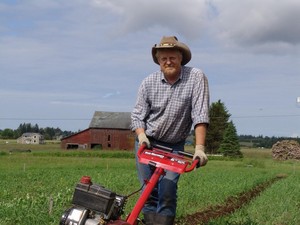14 Mar Sat 2009
Let The Food Do The Talking
Last night Toni and I tried out a new French restaurant in Bellingham. We gave it a B on food and a C on service. First the waitress. Aside from being slow and with traces of that Bellingham "edge" that so infuriates us (sort of like the irritable Portland types transplanted into a cowtown), she was trying hard to be pleasant. Thus a middling grade on service. As for the food, we opted for the specials. Toni had the duck lasagna and the flavors were married quite well, but the duck seemed a little old to me, but not to Toni. I had the cassoulet with pork tenderloin. The flavor was complex but tilted a little too much on the bacon side. The pork tenderloins were added on top of the beans, in the haute cuisine style, but I could have used less pork and more beans. This is, after all, a peasant dish. We had a yam and garlic terrine for an appetizer. Again, the flavors were married quite well in the terrine, but the dish was a bit greasy. I could envision this particular dish with Buttercup squash in place of the yams, as the Buttercup flavor is often referred to as a "sweet potato" taste. We tried two robust red wines by the glass. The cheap Spanish wine was quite good, but I was disappointed in the cheap Washington wine from the Horse Heaven Hills, as it seemed a bit syrupy. This was unusual, as I am usually quite pleased with Washington wine - even the cheaper bottles. Also, I am quite interested in how the Horse Heaven Hills are making their presence known as a distinct wine region. The dinner was pleasant overall, but mostly because of the company, rather than the restaurant.
As I ate, I started thinking about beans and how we grow and cook our own beans. I have several varieties in the cupboard and usually cook them simply. Each kind of bean has a distinct taste of its own and is quite good with a minimum of spice. I usually just add cumin. There is also a complexity in taste that comes from the quality of our soil. Most people can taste this in our salad mix - even compared to other organic salad mixes - but I can taste it in the beans too. Each vegetable, fruit, grain and legume has a distinct complex of flavors that is already "mixed" or "married" inside its cell walls and these flavors are available and waiting to be released under varying conditions of heat, pressure, chemical combination with other flavonoids, etc. Taking this complex of variables and mixing them with another complex of variables, such as the complex of flavors in duck, raises the complexity up another level - complexity squared, as it were. With a good cook or a bulletproof recipe, this "complexity squared" can become quite exquisite, but can also produce utter failures for no apparent reason, Everyone has had this happen to them in the kitchen - all of a sudden, your signature dish flops spectacularly.
Our approach here at F.A. Farm is to put a lot of attention into the food before it is harvested. Then we cook it simply. This works with evolution, as the differing environmental stresses cause the plant to adapt in multiple ways that we can only vaguely imagine. Then we just let the intrinsic flavors out and train our palates to pick up the differences. Most people can taste multiple flavors in a glass of wine. The same training and attention paid to basic foodstuffs, like beans, can pick up many new tastes.


I'm curious-- which place was this? Feel free to email me. I'm a B'ham foodie and I totally get what you're talking about. It makes me crazy how many of our local "fine" dining establishments lost sight of the ingredients.